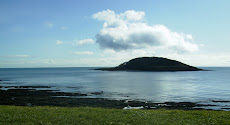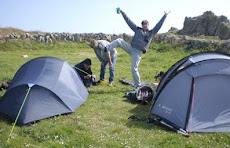Picture the scene. It is February. Three birders are on their way up to the Scottish Highlands for a bit of speciality year ticking. Thoughts of Capercaillie, Ptarmigan, Crested Tit and Scottish Crossbill (yer, right) are in the minds of the enthusiastic trio.
Having travelled overnight it is a misty grey dawn as they hurtle up the infamous A9, one of the most evocative of birding roads. I think it's only ever either the middle of the night or the early hours on that road. Daylight doesn't exist in a strange silent world.
At the wheel is Mark, owner of Dusty Monkey (see the monkey's new blog, now in my blog list - the strange goings on in the head of a Caribbean monkey made of a coconut). Dozing in the back is Dave - who's hat once blew into a tiny ornamental pond in someone's front garden when birding round Silverdale in Lancs, and in the front trying to stay awake as is birding law (the front seat passenger is responsible for ensuring that the driver remains the right side of consciousness), is me.
Daylight comes slowly on the A9, and then as the road stretches out in front of us, with wilderness on either side, far off in the distance, cresting the brow of a hill and travelling quickly in the opposite direction, something appears. We haven't seen a car in what seems hours, but even so I think I can remember what one looks like, and it isn't like the faint shape which is now hurtling towards us. Somehow from the change in atmosphere in the car it is obvious that all three of us have clocked it.
Mark breaks the silence "What's this??" - as whatever it is, and it really hasn't turned into anything remotely recognisable as a normal road user yet, closes in at what seems astonishing speed, and then, in unison we all shout "IT'S A CREME EGG!!!!"
And that's what it is - a creme egg travelling at breakneck speed, with what seems a tiny windscreen and a bloke with a large pair of what look like comedy glasses hunched over the wheel. It passes us in a flash, and is gone, and a strange eerie silence descends as we all digest what we think we've just seen.
No-one believed us when we told them, and for some years afterwards we tried to forget this bizarre occurrence, wondering if it had indeed been a collective hallucination brought on by lack of sleep and oversupply of rubbish food. Several years later, however, I was stopped at a motorway services and there it was. It or another of its kin, with a gaggle of bemused motorists taking photographs. Proof at last! And there it is to convince you too. It might look slightly weird on a city street, but imagine how incongruous this would look hurtling towards you on a remote stretch of scottish road in the early hours of the morning.
brought on by lack of sleep and oversupply of rubbish food. Several years later, however, I was stopped at a motorway services and there it was. It or another of its kin, with a gaggle of bemused motorists taking photographs. Proof at last! And there it is to convince you too. It might look slightly weird on a city street, but imagine how incongruous this would look hurtling towards you on a remote stretch of scottish road in the early hours of the morning.
 brought on by lack of sleep and oversupply of rubbish food. Several years later, however, I was stopped at a motorway services and there it was. It or another of its kin, with a gaggle of bemused motorists taking photographs. Proof at last! And there it is to convince you too. It might look slightly weird on a city street, but imagine how incongruous this would look hurtling towards you on a remote stretch of scottish road in the early hours of the morning.
brought on by lack of sleep and oversupply of rubbish food. Several years later, however, I was stopped at a motorway services and there it was. It or another of its kin, with a gaggle of bemused motorists taking photographs. Proof at last! And there it is to convince you too. It might look slightly weird on a city street, but imagine how incongruous this would look hurtling towards you on a remote stretch of scottish road in the early hours of the morning. So, birding memories are not just about the birds, and to be honest I couldn't tell you what birds we saw on that trip. A trip that also featured an eventful night out in Braemar and an early morning escapade on icy roads where Mark overtook the snow plough going up to Glenshee. But that's another tale!








As the taxomatic, hypochondrial DNA carry on has demonstrated, there is no such thing as a Scottish Crossbill. The 3 "species" have now been lumped as Common McParakeet Crossbeak.
ReplyDeleteThe preferred common name for Capercaillie is now Fenno-austrian Caperreintrocaillie.
best regards
Stuart